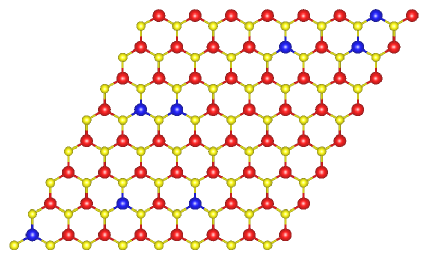Siow Mean Loh
Research
I am a third-year PhD student under the supervision of Dr. Nicholas Hine. I graduated from National Chung Cheng University in 2013 with a Bachelor’s Degree and in 2014 with a Master’s degree in Physics.
I have been interested in transition-metal dichalcogenide (TMDC) materials since I was a research assistant in Taiwan because they have some promising properties, such as direct band gap, which can be utilised in areas such as nanoelectronic and optoelectronic devices. The band gap of TMDC materials can be tuned by various methods, for example, applying external strain [1] and changing the compositions [2-3]. My works for the first two years in my PhD aim to investigate the electronic properties of Mo1-xWxS2 and W1-xNbxS2 monolayer. In my third year PhD, I mainly study the electronic properties of twisted transition metal dichalcodenides homobilayers. ONETEP, a linear-scaling density functional theory (LS-DFT) package are mainly used to do the material simulations.
I have already done some works on the effects of alloying on their electronic properties, for example, band gap, bandwith, effective mass and the splitting of valence band maximum (VBM) and conduction band minimum when considering spin orbit coupling for Mo1-xWxS2 monolayer. Those properties are also compared with the experimental data from Dr. Neil Wilson’s group and virtual crystal approximation (VCA). Some of our LS-DFT results quite match to the experimental results, as well as other literatures. The atomic configuration of this alloy has also been investigated through DFT calculations and Monte Carlo calculations.
For W1-xNbxS2 monolayer, the atomic configurations are quite different from the Mo1-xWxS2 monolayer. This is because it is an alloy which composed of a metal (NbS2) and a semiconductor (WS2). So it is expected that it is not similar to the Mo1-xWxS2 monolayer, which is an alloy composed of two semiconductors. This atomic configurations further influence its electronic properties.
Twisted bilayer graphene has attracted lots of attention from scientists recently. The origin of flat band at magic angles has been explained with a continuum model in previous study [4]. Twisted transition metal dichalcogenides becomes another interesting topics to study. The moire bands was shown topologically nontrivial and topological insulators realised in this kind of twisted bilayers was discussed in [5].
There are still some other interesting properties and TMDC materials worth investigating and I will keep going to study this kind of materials.
References
[1] H. L. Shi, H. Pan, Y.-W. Zhang, and B. I. Yakobson, Phy. Rev. B 87, 155304 (2013)
[2] W. T. Zhang, X. D. Li, T. T. Jiang, J. L. Q. Song, Y. Lin, L. X. Zhu and X. L. Xu, Nanoscale 7, 13554 (2015).
[3] B. Huang, M. Yoon, B. G. Sumpter, S.-H. Wei and F. Liu, Phys. Rev. L 115, 126806 (2015).
[4] G. Tarnopolsky, A. J. Kruchkov and A. Vishwanath, Phys. Rev. L 122, 106405 (2019).
[5] F. Wu, T. Lovorn, E. Tutuc, I. Martin and A. H. MacDonald, Phys. Rev. L. 122, 086402 (2019).
Publications
1. (Han Hu, Siow Mean Loh)*, Tsan-Chuen Leung and Ming-Chieh Lin, RSC Adv. 8, 22625 (2018). RSC Adv 8, 22625
2. Siow Mean Loh, Yu-Hui Huang, Ken-Ming Lin, W. S. Su, B. R. Wu and T. C. Leung, Phys. Rev. B 90, 035450 (2014). PRB 90, 035450
*Co-first author

